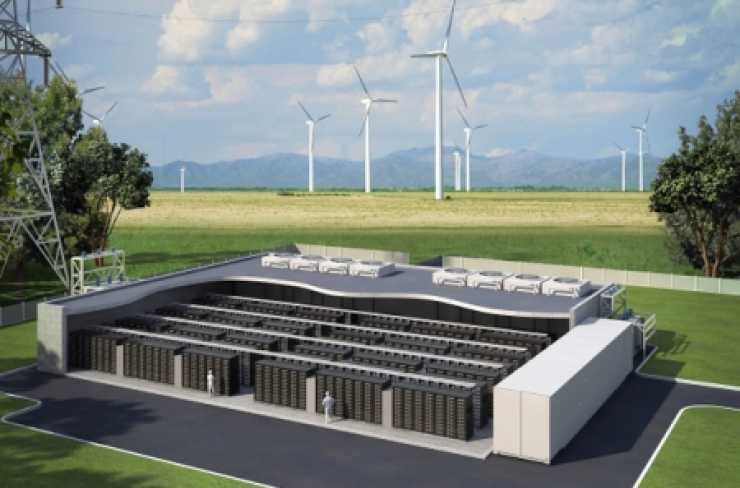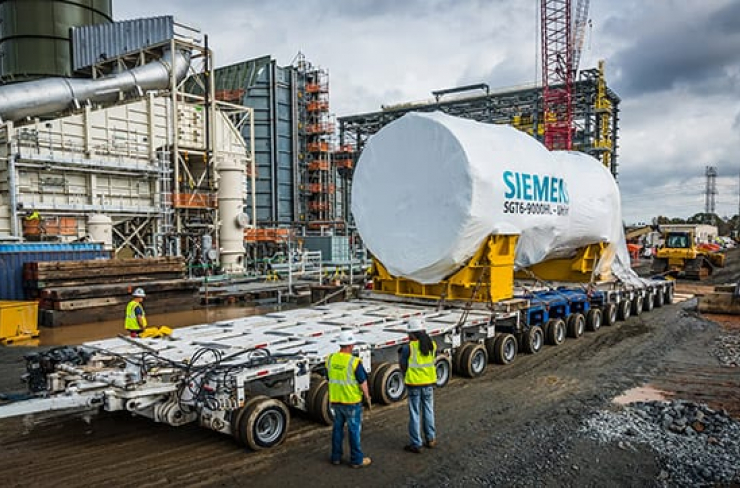When Abu Dhabi launched the world’s cheapest solar plant last year, it was the third time in two years that the UAE was breaking the record for producing the cheapest solar.
But the UAE’s capital has far bigger ambitions for its power sector than setting or breaking world records.
“For us, it is not about just breaking world records,” says Othman Al Ali, chief executive officer of the Emirate Water and Electricity Company (EWEC).
“Our mandate is rooted in the need to provide power and water security to the residents of Abu Dhabi through ways that are affordable, sustainable and efficient.”
With enough electricity produced on the eight square kilometre site to power 90,000 homes, the 1.17GW Noor Abu Dhabi is a clear reflection of that mandate.

At 2.94 US cents per kilowatt-hour, Noor demonstrates that large-scale renewable energy can compete with fossil fuels, which today typically cost in the range of 4-6 US cents per kWh.
With 3.2 million solar panels installed, it is the largest facility of its kind in the world. It is also playing its part in the battle to reduce carbon emissions and address climate change, reducing the Emirate’s CO2 emissions by one million metric tonnes, the equivalent of taking 200,000 cars off the road.
But with more than $872mn invested in the Noor solar plant through a combination of debt and equity, this seems to be just the beginning as Abu Dhabi aims higher.
“Our short and medium term priority is to maximise the penetration of renewable energy throughout Abu Dhabi by integrating the best technologies within the industry,” says Ali.
“Technological innovations are now helping to further drive down the cost of solar power generation. This is very important for our long term solar goals.”
The UAE is aiming to increase the contribution of renewable energy in the country to 50% and reduce the carbon footprint through power generation by 70% by 2050, a target that EWEC is aligning itself with.
In July, EWEC announced that it had floated a construction and development tender for a 2GW solar plant on a 20km2 stretch in Abu Dhabi’s Al Dhafra.
Successful bidders will hold a 40% interest in the solar plant, with the remaining stake owned by local companies, in line with the Abu Dhabi government’s 1998 independent water and power producer policy.
“This will be a very important project once completed in 2023. The tender is currently under evaluation and the winners will be announced soon,” says Ali.
Ali says that all bidders for the Al Dhafra solar plant have added an element of storage in their submissions, which indicates the growing importance of storage technologies in large scale solar deployments.
In fact, last year, Abu Dhabi launched the “world’s largest Virtual Battery Plant” by deploying 15 systems of up to 108MW/648MWh Sodium sulfur (NAS) batteries across 10 locations.
Produced by Japan’s NGK Insulators with a total undertaking of 12 x 4MW systems and three 20MW systems, each system is capable of storing energy up to six hours.
The NGK CISC 648MWh project will help the emirate load balance across its networks during the daytime, as well as providing up to six hours backup in the case of grid outages. As with many energy storage system projects, it is primarily about reducing the strain on the grid at times of peak demand.
In the next four years, Abu Dhabi is expected to scale up its aggregate renewable energy capacity with up to 9GW of baseload nuclear and solar energy, summing up capacity from concentrated solar power (CSP) and photovoltaic (PV) plants.
Barakah nuclear power plant, which last month received a licence to operate, will add 5.6GW of baseload capacity to Abu Dhabi’s independent power capacity when all four units become fully operational.
It is being constructed by a consortium led by Korea Electric Power Corporation (KEPCO) at a cost of $24bn and Unit 1 is expected to start commercial operations in 2020.
Ali says that advancements in inverter technology will boost grid stability as more renewable energy plants get connected to the main grid.

With about 16.6 gigawatts (GW) of power generation capacity and 14.7GW of peak demand as of 2017, Abu Dhabi still ranks first in the UAE and third among GCC countries in terms of generation assets and peak demand, according to statistics from a report by King Abdullah Petroleum Studies and Research Centre (KAPSARC).
Since 2018, the utility sector of Abu Dhabi has undergone a series of structural reforms, creating new government bodies and reorganizing existing ones with the overall goal of ensuring reliable and cost-effective power and water supply for UAE capital and northern emirates.
The restructuring saw the creation of EWEC to replace Abu Dhabi Water & Electricity Company (ADWEC) as the offtaker for utilities in Abu Dhabi. It is responsible for unifying power and water production and supply in Abu Dhabi and the northern emirates.
Following the restructuring, the Department of Energy (DoE) was created to take over the functions of Abu Dhabi’s former utility, the Abu Dhabi Water and Electricity Authority (ADWEA) and the former Regulation & Supervision Bureau (RSB).
EWEC operates under an existing entity, Abu Dhabi Power Corporation (ADPC), which has since the restructuring seen its role streamlined to manage assets across five emirates.
“Our efforts are guided by the Abu Dhabi Economic Vision 2030 which aims to achieve effective economic transformation of the Emirate’s economic base and bring about global integration and enduring benefits to all,” says Ali.
“Therefore, a key ingredient of our success will be how we can sufficiently meet the needs of business, industry as well as individual consumers through provision of power and water services.”
In September, Abu Dhabi announced that $900mn had been secured for the construction of what is expected to be the world’s largest reverse osmosis (RO) water desalination plant
The plant, with a capacity of 909,200 cubic metres per day and 44% larger than the world’s current largest RO plant, in Al Taweelah power and water desalination complex.
The tariff provided for the desalinated water by Saudi Arabia’s ACWA Power, developer for the Al Taweelah IWP, is the world’s lowest so far. By using the least amount of energy per gallon of desalinated water delivered, the project is on track for another world record when completed.
Besides the 11 desalination plants that supply water to Abu Dhabi, groundwater continues to be a significant source and plays a key role in the emirate’s overall water supply.
Last year, Abu Dhabi launched the Liwa aquifer, the world’s largest 26 Mm3 desalinated water reserve. It is enough to store 5.6 billion gallons of water, or enough to supply one million people with 180 litres of drinking water for up to 90 days.
But in order to promote water conservation, the UAE Water Security Strategy 2036 has been established to tremendously scale down demand for water resources by 21% and boost the reuse of treated water to 95%. It also aims to increase national water storage capacity up to two days.
Abu Dhabi has set targets for minimising water losses to 10%, reducing the intensity of indoor and outdoor water use to 12%, and increasing recycled water use to 100% by 2030.
Ali says that the next few years will see a decline in investments in Greenfield thermal power generation plants as focus completely shifts towards renewable energy.

But last month, Abu Dhabi Power Corporation (ADPower) and Japan-based Marubeni Corporation announced the formation of a consortium to develop the Fujairah F3 independent power producer (IPP) project, which will be the largest independent thermal power plant in the UAE.
The Fujairah F3 IPP project includes the development, financing, construction, operation, maintenance and ownership of a combined cycle gas turbine (CCGT) power plant, together with associated infrastructure.
Located in the Fujairah water and electricity complex, between the existing Fujairah F1 and Fujairah F2 water and electricity plants, the Fujairah F3 IPP project will have a contracted power capacity of 2.4GW, bringing ADPower’s current power generation capacity to 20.4GW.
Once operational, Fujairah F3’s capacity will be able to power the equivalent of 380,000 households.
“The Fujairah F3 IPP project will apply one of the most efficient and advanced CCGT technologies available in the region, producing more energy that aligns with the UAE Energy Strategy 2050’s CO2 emissions reduction targets,” says Ali.
“It will play a strategic role in the growth and development of the UAE, providing secure and reliable power to match the needs of consumers in Abu Dhabi and the UAE.”
Ali says that this will most likely be the last thermal power plant to be built in the UAE, in the foreseeable future as renewables gain traction.
However, industry players as well as manufacturers of gas turbines used in gas power plants contend that current and future demand for electricity in the UAE cannot be solely addressed by renewable energy deployments.
“The world will have to depend upon a mix of conventional resources and renewable power to meet the need for dependable, affordable and sustainable energy over the foreseeable future. Traditional and alternative sources should be seen as complementary, not competing forces, to meet our electricity needs,” says Joseph Anis, President & CEO of GE Power in the Middle East, North Africa and South Asia.
“However, business as usual will not work. We need to develop solutions that are a better fit for our evolving reality. That means investments in technologies that are more efficient and flexible so they release fewer emissions, have lower life-cycle costs and are more flexible so they can ramp up and down faster to stabilise the grid in response to intermittent renewable energy. Hybrid technologies offer another viable solution.”
The gas turbine sector–led by companies such as Siemens, Mitsubishi Hitachi Power Systems (MHPS), Rolls-Royce, Ansaldo Energia and Kawasaki Heavy Industries, among others–is expected to grow at an annual rate of approximately 1.4 percent over the next seven years, the summary indicates.
Globally, sales for gas turbines have fallen sharply, under pressure from low-cost renewable energy, and are expected to remain weak for at least another couple of years. The current global industrial gas turbine market last year was estimated at more than $9bn.
Manufacturers such as MHPS and Siemens see hydrogen as the bulk energy storage solution for a sustainable, cost-effective, and reliable renewable energy future. As the build-out of wind and solar continues, excess renewable energy will increase and can be used to create renewable hydrogen through electrolysis, which uses electricity to split water into hydrogen and oxygen.
The resulting hydrogen, a clean fuel that can be used in gas turbines, can be stored for solid-oxide fuel cells, transportation, and chemical production industries.

Renewable hydrogen represents a multifaceted breakthrough. It can be generated from low-cost or free excess renewable energy. It can be stored for long durations, even on a seasonal level. And it can readily be combusted in gas turbines with the proper system design modifications.
“We are open to any technology that will help us to guarantee security of power and water supply by embedding operational efficiency,” says Ali.
“Our strategy is geared towards achieving certainty in the power and water sector. We have created an environment that embraces innovation as the main driver of progress in the sector.”
But for now, Ali is more concerned with boosting renewables capacity in the capital, with all indicators very much in favour of solar technology.
“Beyond renewable energy technologies, we see significant innovations in project structuring and financing, which are all crucial in boosting the competitiveness of renewables in the years to come,” says Ali.
What Ali wants is an emirate that can guarantee security of power and water supply at the lowest cost. And so far, the future looks bright as Abu Dhabi switches on more solar plants.






